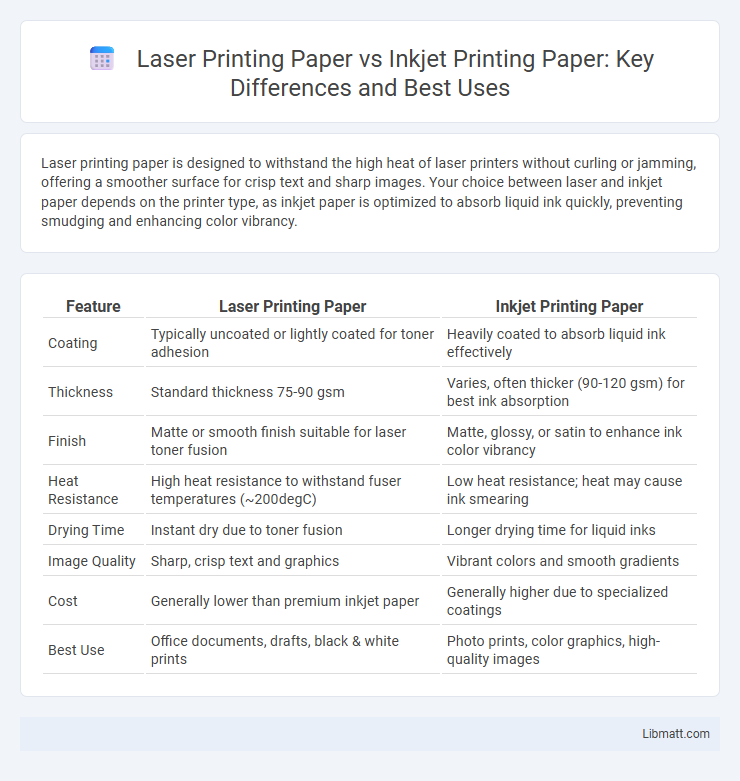Laser printing paper is designed to withstand the high heat of laser printers without curling or jamming, offering a smoother surface for crisp text and sharp images. Your choice between laser and inkjet paper depends on the printer type, as inkjet paper is optimized to absorb liquid ink quickly, preventing smudging and enhancing color vibrancy.
Table of Comparison
| Feature | Laser Printing Paper | Inkjet Printing Paper |
|---|---|---|
| Coating | Typically uncoated or lightly coated for toner adhesion | Heavily coated to absorb liquid ink effectively |
| Thickness | Standard thickness 75-90 gsm | Varies, often thicker (90-120 gsm) for best ink absorption |
| Finish | Matte or smooth finish suitable for laser toner fusion | Matte, glossy, or satin to enhance ink color vibrancy |
| Heat Resistance | High heat resistance to withstand fuser temperatures (~200degC) | Low heat resistance; heat may cause ink smearing |
| Drying Time | Instant dry due to toner fusion | Longer drying time for liquid inks |
| Image Quality | Sharp, crisp text and graphics | Vibrant colors and smooth gradients |
| Cost | Generally lower than premium inkjet paper | Generally higher due to specialized coatings |
| Best Use | Office documents, drafts, black & white prints | Photo prints, color graphics, high-quality images |
Introduction to Printing Papers
Laser printing paper is specially designed to withstand the high heat and pressure from laser printers, featuring a smooth surface and higher brightness to produce sharp text and images. Inkjet printing paper, on the other hand, has an absorbent coating to hold liquid ink droplets, preventing bleeding and ensuring vibrant color reproduction. Your choice of paper directly affects print quality, durability, and suitability for specific projects.
Understanding Laser Printing Paper
Laser printing paper is specially designed to withstand the high heat produced by laser printers, featuring a smooth surface and a higher weight to prevent curling and smudging during the fusing process. It typically has a tightly controlled texture that ensures optimal toner adhesion, resulting in sharp, vibrant images and text. Unlike inkjet paper, which is porous to absorb liquid ink, laser paper's coatings resist toner toner flaking and ensure durability, making it ideal for professional documents and high-volume printing.
Understanding Inkjet Printing Paper
Inkjet printing paper is specially designed to absorb liquid ink without smudging, ensuring sharp, vibrant images and precise text. It typically features a coating that prevents ink from spreading, which differs from laser printing paper that must withstand high heat from toner fusing. Choosing the right inkjet paper enhances your print quality by reducing drying time and improving color accuracy.
Key Differences Between Laser and Inkjet Papers
Laser printing paper is designed to withstand high heat and pressure from the laser printer's fuser, featuring a smooth, sturdy surface ideal for sharp text and graphics. Inkjet printing paper typically has an absorbent coating that allows quick ink absorption, preventing smudging and enhancing color vibrancy but making it less heat-resistant. Key differences include paper weight, surface texture, and coating composition tailored to match the respective printing technology's requirements for optimal print quality and durability.
Paper Weight and Thickness Comparison
Laser printing paper typically ranges from 20 to 24 pounds with a thickness of about 3.8 to 4.5 mils, designed to withstand the high heat and pressure of laser printers without curling or jamming. Inkjet printing paper often features a wider weight range from 20 to 32 pounds and a thickness between 3.5 to 6 mils, optimized for ink absorption to prevent smudging and maximize color vibrancy. Choosing the right paper weight and thickness ensures optimal print quality and durability for the specific printing technology.
Coating and Surface Texture
Laser printing paper typically features a smooth, heat-resistant coating designed to withstand high temperatures during the fusing process, ensuring sharp text and images without smudging. Inkjet printing paper possesses a porous, absorbent surface texture that allows ink droplets to be quickly absorbed and dried, enhancing color vibrancy and preventing ink bleeding. Choosing the right coating and texture for your printing needs can significantly improve print quality and durability.
Print Quality and Color Accuracy
Laser printing paper is engineered to withstand high heat and fuse toner particles, delivering sharp text and crisp images ideal for professional documents. Inkjet printing paper features a specialized coating that rapidly absorbs liquid ink, preserving vibrant colors and fine details for high-quality photo prints. Choosing the right paper enhances your print quality and color accuracy, ensuring your projects meet precise visual standards.
Compatibility with Printers
Laser printing paper is specifically designed to withstand the high temperatures of laser printers, ensuring crisp text and images without smudging or curling. Inkjet printing paper features a porous coating that absorbs liquid ink, preventing bleeding and promoting vibrant color reproduction on inkjet printers. Using the correct paper type for each printer technology enhances print quality and reduces wear on printing equipment.
Cost Considerations
Laser printing paper typically costs more upfront than inkjet printing paper due to its thicker, smoother surface designed to withstand high heat from laser printers. However, laser paper's durability and reduced likelihood of smudging or curling can lower replacement costs over time, making it more cost-effective for high-volume printing. Choosing the right paper for your printer helps optimize overall expenses and print quality based on your specific printing needs.
Choosing the Right Paper for Your Needs
Choosing the right paper for your printing needs depends on the printer type and desired output quality. Laser printing paper is designed to withstand high heat and pressure, preventing smudging and ensuring sharp text and graphics, ideal for professional documents and bulk printing. Inkjet printing paper features a coated surface that absorbs ink effectively to produce vibrant colors and detailed images, making it perfect for photographs and high-resolution graphics.
Laser printing paper vs inkjet printing paper Infographic

 libmatt.com
libmatt.com